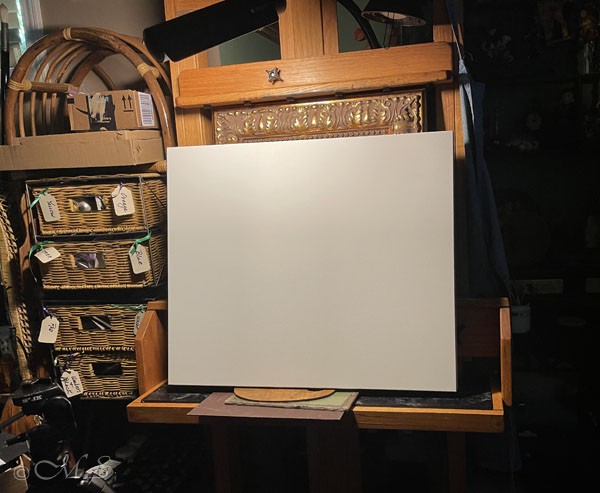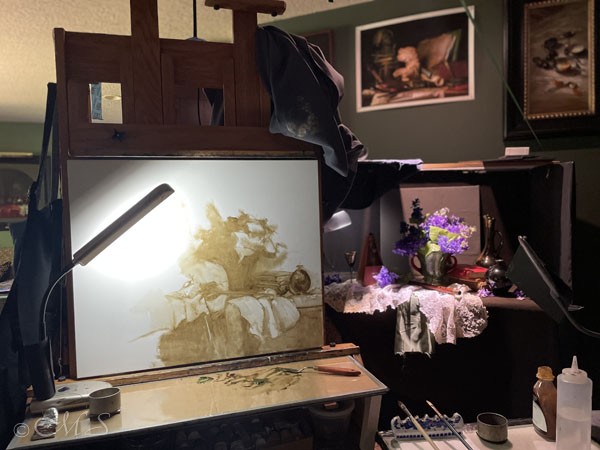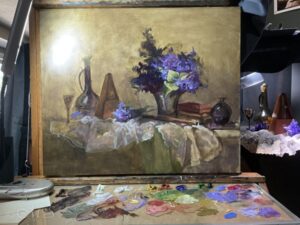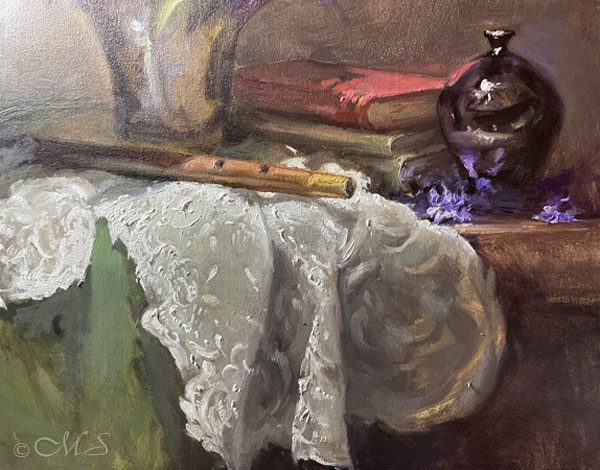Part One
One of the most enjoyable projects in my painting life is working directly with collectors planning a commission piece, and this was no exception and loads of fun. Several months ago, a couple from nearby Washington State contacted me inquiring about a very personal painting for their collection. They wished to include a few heirloom items, and they had very specific ideas about the composition. This is important as an artist to know what the client sees in their mind’s eye first. Because of their specificity, I had lots to work with, because he is a musician, hence the metronome and the fife, and she loves flowers and lace. A perfect combination.
Choose Archivally Sound Materials

The first item on the agenda was to order a primed canvas. For this very important project, I chose an Artefex panel primed with the smoothest Belgian Linen available. It is an archivally sound product adhered to the surface of an acid free aluminum substrate in the desired size, here a 20×24. In the past I have used this type of panel minimally and knew it was something to try in a larger format. This surface is dynamite to paint on and accepted the paint beautifully all the way to the end.

After extensive discussions with the clients, we settled on a composition to accommodate their personal objects, color scheme of muted green, sienna/warm muted red, soft violet/blue, and lots of neutral grays. The gentleman is a retired schoolteacher who plays in the One More Time Around Marching Band, and emphasized he wanted a strong chiaroscuro feel to the painting as well. His wife, who also taught school, loves lilacs and grows many in her garden, wanted a big section of lace in the painting.
The Plan/Idea are the Most Critical Steps
After many hours of trial and error, the composition began to take form using the selected items; the metronome, fife, lace, lilacs, and not clearly seen on the far right is a black vase, and on the far left a carafe and small cordial. A grisaille is a perfect method for the initial drawing and lay-in of the composition. Using just raw umber and a small amount of odor free solvent and medium, I drew the set-up on the blank canvas using a brush.
A Tried-and-True Technique; Grisaille


Colors Next

Because painting lilacs can be daunting, choosing the right pigment is essential. A variety of violets were used including magenta, quinacridone rose, and one of my favorites, Sinopia’s alizarin violet. (My jar of this pigment is very old and possibly is no longer available). Any of these colors mixed with ultramarine blue or cobalt blue will make spectacular violet tones. I find that any violet should be muted or knocked down with another color such as terra verte or an ochre. Savor one small choice area to use the pow! factor with tiny strokes of a purer saturation. Other pigments include ultramarine blue, lead white, burnt sienna, burnt umber, Ivory black, and yellow ochre. I wanted to use as many natural pigments as possible, but violets/purples are difficult to achieve unless they are synthetic.
A Painting Within a Painting
This technique has been used throughout the centuries. When painting a mirror or something with a bold reflective quality, it is lots of fun to replicate the surroundings that reflect into or onto the surface of the object. The clients love the painting The Arnolfini Portrait by Jan van Eyck where the artist painted the entire scene in the mirror on the back wall behind the two figures. Here, I painted the items reflected onto the surface of the black vase, the lace, books, and lilacs.

So now you have the initial thought process that goes into the planning and execution of a commissioned painting. This is a labor of love for sure, that at this point in the process, has taken several months and many hours of studio work. It is exciting to hear what people want in their homes. They want original art that speaks to them. This is very different from painting pieces for a gallery. You never know who will come along and see something on the wall and find it irresistible and then purchase it. Doing a personalized painting for clients who have very specific ideas is both fun and a big responsibility. It is also an honor to collaborate with collectors and know that they will display your painting in their home and then pass it down to heirs.
Part two coming soon!
Watch for images showing how the piece gets finished and the final reveal.

there is more to this process than I had ever thought. I thoroughly enjoyed reading the process. In fact I read it twice.
The painting is absolutely beautiful. I wouldn’t expect less from such a professional artist such as you, Margret.
The pallet had so many colors it is hard to believe so many are needed but only you would know that.
You are correct, Charlot. It is a process and a big undertaking where careful planning is of the essence. This pays off in the end and makes the work go smoothly and is more enjoyable too. Careful color choices and composition considerations are important pre-painting chores. Another factor viewers don’t think of, but is essential, is the shape of the negative area. This is the area where there is nothing except perhaps air. This has to be interesting too! Ah Ha! there is another thing to think about! Thanks again for your insight.
This is beautiful! What a special treasure they have to pass down through the generations to tell their story.
Thank you, Michelle, for your thoughtful comment. And yes, it is gratifying to know it will be passed down through the generations.
I only ever produced one painting that could be considered a ‘Commission’ – a watercolour of a steam locomotive in blue and red livery. My clients passed away without issue, and left the painting to me in their will, but my irreverent sons both refer to it’s colour scheme as like the cartoon creation “Thomas the Tank Engine”.
Ha! I am sure it is a fine steam locomotive and has its own lovely story.
Lovely work.
Thank you, Virginia, for your nice comment.
Thank you for this lovely account of a commission. The Artefex Belgian linen panel is delicious to paint on! I appreciate al the planning and work you put into this piece. You have very fortunate (and wise) clients!
Yes, Lisa. The Artefex Linen panels are a luscious surface to paint on. I have just become aware of this product and was completely enamored the first go at it. And to know it is archivally safe too is a bonus. I prefer the smooth texture, but I am sure you can get it in whatever is a favorite.
Thank you for showing us your process so we see your beautiful picture come to life!
Thank you, Holly. Glad you liked seeing the thought process that it takes to bring a painting to life.
Beautiful, and I never expect any less with this artist.
I personally have 5 canvases of her work. They grace my walls with beauty that I never get tired of and I proudly tell them about Margret Short and her talent and that she is an International artist.
Thank you Margret for sharing a glimpse into how you lay out accomplish an oil painting. I will be in Portland this late summer and I would love to see you and tour your studio. Joanne Yost
I can’t wait to see you in late summer and will welcome you into my studio. I also am so happy to know you enjoy your paintings. It is comments like yours that keep artists like me chained to our easels.
I’ve admired your work for quite some time
This is a beautiful painting and I look forward
To seeing it progress! Thank you for sharing,!
Joni
Thank you, Joni, for your nice comments. I will get the final chapter published soon.
Wow! Architecture in action. What a wonderful adventure.
You are right! One building block after another and voila!